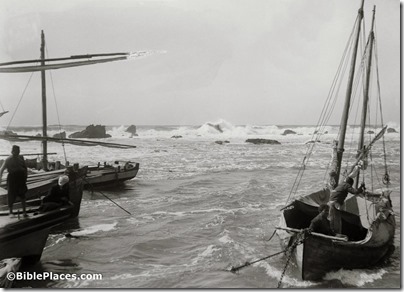On Jan 6, 2016, the New York Public Library released more than 187,000 items in their digital collection into the public domain. Mark Hoffman sent along some of the treasures he found and that motivated me to dig deeper. The list below reflects highlights of what we discovered.
You might begin by checking out the interesting visualization of the project. When you’re sufficiently overwhelmed, you can follow the direct links below, beginning with collections including the land of Israel and concluding with Egypt, Mesopotamia, and biblical manuscripts.
The Holy Land, Syria, Idumea, Arabia, Egypt and Nubia. From drawings made on the spot by David Roberts . . . With historical descriptions by the Revd. George Croly . . . Lithographed by Louis Haghe, 1842-49. 252 images.
Egypte, Nubie, Palestine et Syrie : dessins photographiques recueillis pendant les années 1849, 1850 et 1851 [Egypt, Nubia, Palestine and Syria: Photographic Drawings Collected during the Years 1849, 1850 and 1851], by Maxime Du Camp, 1852. 127 images.
Jérusalem: étude et reproduction photographique des monuments de la Ville Sainte, depuis l’époque judaïque jusqu’à nos jours [Jerusalem: study and photographic reproduction of the monuments of the Holy City from the Jewish era to the present], by Auguste Salzmann, 1856. These 42 images are the earliest known photographs of Jerusalem.
Palestine, by Robertson and Beato, 1857. 19 images.
Egypt and Palestine, by Francis Frith, 1858-59. 78 images.
Sinai and Palestine, by Francis Frith, 1862(?). 40 images.
Plates from the Queen’s Bible of 1862. 71 images.
Jerusalem Explored, being a description of the ancient and modern city, with numerous illustrations consisting of views ground plans, and sections, by Ermete Pierotti. Translated by Thomas George Bonney, 1864. 64 images.
Ordnance Survey of Jerusalem, by Charles W. Wilson, 1865. 46 images, but it does not include the survey map.
Views of Egypt, Palestine and Syria, by Félix Bonfils, 1867-71. 32 images.
Palestine and Syria, by Bonfils, Zangaki, and Arnoux, 1870s. 19 images.
Voyage d’exploration a la mer Morte, a Petra, et sur la rive gauche du Jourdain [Exploration of the Dead Sea, Petra, and the Left Side of the Jordan River], by Melchior Vogüe, 1874. 84 images.
Picturesque Palestine, Sinai and Egypt, by Charles W. Wilson, 1881-84. We like our version better, but this one is free.
Maps of Asia, 1890. 64 images.
Palestine and Egypt, March 1894, by Bonfils, Zangaki, and Arnoux, 1894. 65 images.
Assortment of photographs of Palestine and Jerusalem, 1870-1900. 36 images. Includes some of the American Colony photographs.
Views of Interesting Places in the Holy Land. Published by the American Sunday School Union. 8 sketches that are not high quality.
From Egypt . . .
Description de l’Égypte: ou, Recueil des observations et des recherches qui ont été faites en Égypte pendant l’expédition de l’armée française [Description of Egypt: and Reports of observations and research that have been made in Egypt during the expedition of the French army], 1809-28. 903 images. The extraordinary work of Napoleon’s expedition.
Pantheon Egyptien: Collection des personnages mythologiques de l’ancienne Egypte [Egyptian Pantheon: Collection of Mythological Figures of Ancient Egypt], by L. J. J. Dubois and J. F. Champollion, 1823-1825(?). 90 color illustrations.
Manners and Customs of the Ancient Egyptians, by J. G. Wilkinson, 1837. 100 images.
Pyramids of Gizeh, from Actual Survey and Admeasurement, by J. S. Perring, 1839-42. 62 illustrations.
Monuments Égyptiens, bas-reliefs, peintures, inscriptions, etc., by E. Prisse d’Avennes, 1847. 54 images.
Collection of Views of Egypt, including Cairo and the Pyramids, by G. Lékégian and Pierre Marchandon de La Faye, 1880s or 1890s. 58 images.
From Mesopotamia . . .
Monuments of Nineveh, from Drawings Made on the Spot, by A. H. Layard, 1849. 100 plates.
Monument de Ninive, découvert et décrit, by Paul Emile Botta, 1849-50. 398 images.
Voyage en Perse [Travels in Persia], by Eugène Flandin and Pascal Coste, 1851-54. 346 images.
A second series of the Monuments of Nineveh; including bas-reliefs from the palace of Sennacherib and bronzes from the ruins of Nimroud, by A. H. Layard, 1853. 73 images.
Ninive et l’Assyrie [Nineveh and Assyria], by Victor Place, 1867-70. 90 images.
The Bronze Ornaments of the Palace Gates of Balawat (Shalmaneser II, B.C. 859-825); edited, with an introduction by Samuel Birch; with descriptions and translations by Theophilus G. Pinches, 1880-[1902]. 94 images from the palace of the king we now call Shalmaneser III.
Biblical Manuscripts . . .
Samaritan Pentateuch, 1232. These 277 images are currently only available in low resolution.
The Xanten Bible, from Xanten, Lower Rhineland, 1294. Includes the Torah and Writings. There’s more information about this manuscript here. 518 images in low resolution.
We welcome suggestions of other collections that we missed. Add a note in the comments or send us an email (see address in sidebar) and we will update this list.

